Firefox Does Not Open: What to Do to Fix Firefox
Firefox Won’t Open! What Now?
Mozilla Firefox is the world’s most popular web browser and is world-renowned for its stability and security. However, even this great
piece of software can sometimes have problems. More often than not, these Firefox problems can have simple causes, but to the user it can be confusing and raise alarms about malicious software, virus infections, Trojans, or worse. The most important thing to do first if you have a problem opening Firefox is to not panic. While the problem could be significant, such as an infection, it is more than likely one of two possible common scenarios and not at all threatening.
Possibility One: Firefox is Still Running
Unbelievably, the most likely reason that Firefox will not open is that it is already open. This can happen for a variety of reasons, most of which involve other software that is conflicting with the Firefox functionality. It could be anything from anti-virus software to communications packages that sometimes prevent Firefox from closing properly. It could be something as simple as a website that was busy when the user closed Firefox last. In either case, if Firefox is still running, the solution is just as simple.
However, if Firefox is still running the user will not know it until he or she attempts to open it again. This is because the process is still active in the computer’s memory but not operating. The first step to dealing with this is to access the Task Manager on a Windows computer and manually stop Firefox from running. The section belows details instructions for how to do this.
Fixing The Double Firefox Problem

First, right click on a blank area of the taskbar. If other windows are open, make sure that when right clicking, not to do so over one of the icons for an open window or on the desktop itself (see screenshot). If the user has right clicked in the right place, then a menu will pop up and including the “Task Manager” option, which is the one to click.
A new window will open with several tabs across the top; one of them is labeled “Processes,” which is the one to look for. Click on the tab to select it and you will see a window that lists all the processes that are currently active on your computer. Look down the list until you find the entry for Firefox. Once found, click on it to

select it. Once Firefox is selected,
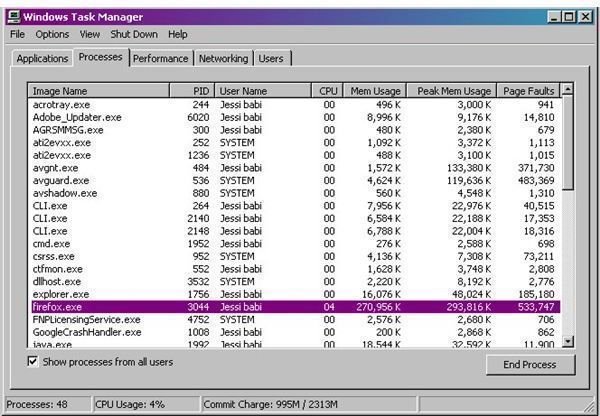
labeled “End Process.”
A
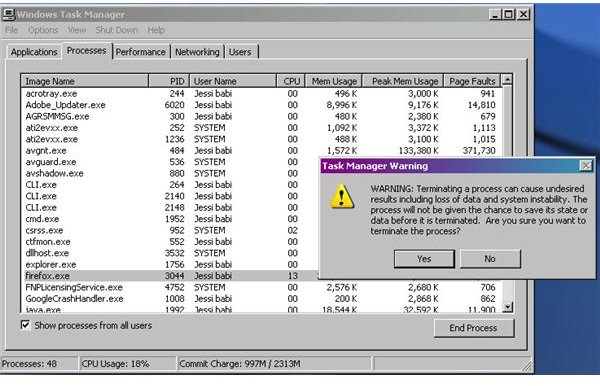
with a warning window about terminating the running process and asking if you are sure, click, “Yes.” If you have tried to start Firefox and it failed and you find it in the running processes list its safe to click “OK”. Once it is closed from the Task Manager, Firefox should start normally when you try to open it.
Possibility Two: Conflicting Firefox Add-ons
While the first fix assumes that when the user tried to start Firefox, it failed to open or the user received a message saying that is was already running. If however, any other error message was received, the problem is probably the second most common; a conflict with a Firefox add-on.
Add-ons are some the most popular features in Firefox, and users can add as many as they want to increase the functionality and customization of the browser itself. Unfortunately, they are also sometimes the most incompatible features of Firefox as well. With the current version of Firefox a user has installed, it is entirely possible that the add-ons are not compatible with it, thus causing a conflict when opening. Usually, Firefox will automatically detect a situation such as this, but sometimes it does not. If not, and Firefox does not open, if the user knows that Firefox or one of its add-ons were recently updated, then the most likely culprit is that one of the add-ons conflicts with the browser.
Fixing a Conflicting Firefox Add-on
The easiest way to confirm that an add-on is conflicting with Firefox is to start Firefox in “Safe Mode.” To do this, go to the “Start” menu
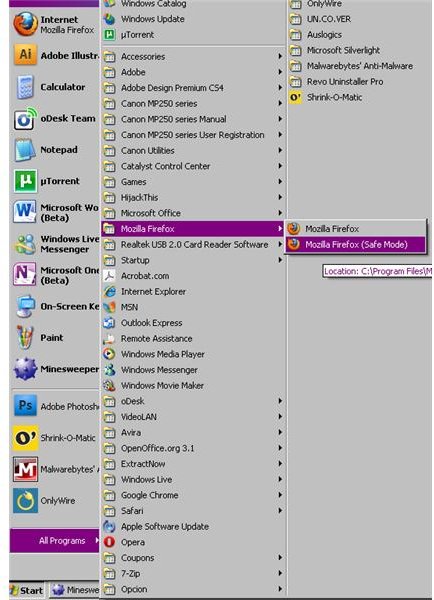
then hover over “All Programs.” Wait for the menu to display all programs installed and then hover over the entry for “Mozilla Firefox” to make the context menu pop up.
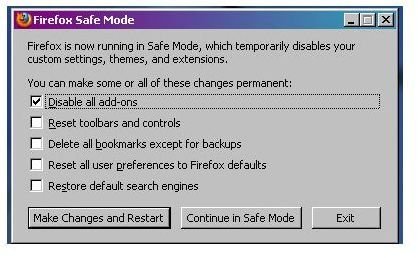
and when the dialogue box opens, select the option “disable all add-ons.” Then, select “Start Firefox in Safe Mode.” If Firefox starts, then the problem is indeed an add-on.
To determine which add-on is conflicting with Firefox and causing it not to open properly, the process is simple, but time-consuming. After confirming that Firefox does open in Safe Mode, the user must enable each add-on one by one and only one at a time. This way, using deductive reasoning, the user can determine the conflicting add-on.
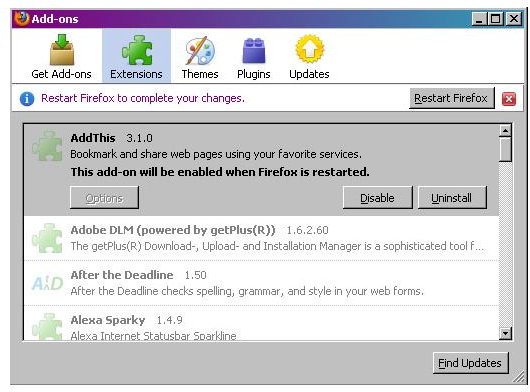
With Firefox open in safe mode, click on “Tools” from the menu bar at the top of the browser. Then, when the context menu opens, click “Add-ons.” All add-ons should be grayed out because they are disabled. Simply click the first add-on and click, “Enable.” You will need to restart Firefox to complete the add-on enabling. If Firefox opens, that particular add-on is not the problem. Disable the add-on and move to the next one, repeating the steps until the user has found the add-on causing the problem.
Once the user has found the problematic Firefox Add-on, he or she must either disable it permanently or attempt to find a more compatible version of it. Either way, visiting Mozilla Firefox’s Add-ons website can not only help find a suitable replacement for the faulty add-on, but it can also offer the user more support and the ability to receive help from Mozilla with the issue.
Support & Sources:
Mozilla Firefox Support Page
